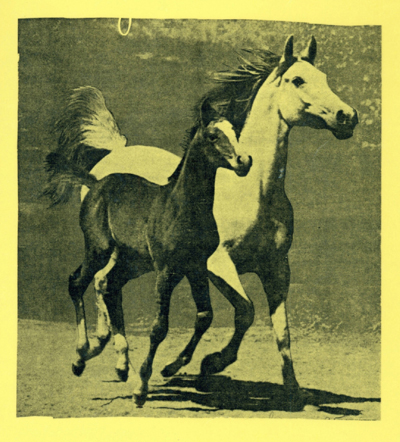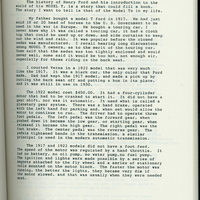061
Item
-
Title
-
061
-
Transcription
-
THE MODEL T FORD
The history of Henry Ford and his introduction to the world of his MODEL T, is a story that could fill a book. The story I want to tell is that of the Model Ts in my life.
My father bought a model T ford in 1917. He had just sold 18 or 20 head of horses to the U. S. Government to be used in the war in Europe. He bought a touring car, I never knew why it was called a touring car, it had a cloth top that could be used up or down, and side curtains to keep our the wind and rain. It was popular before the closed sedan was manufactured. I recall hearing long discussions among MODEL T owners, as to the merit of the touring car. Some said that the sedan was too tightly enclosed and would never sell, some said it would be too hot, not enough air, especially for those riding in the back seat.
I courted Verna in a 1922 model that was very much like the 1917. It was a black car, the only color that Ford made. Dad had kept the 1917 model, and made a pick up by cutting the back seat off and putting a box in its place, and it was still in use in 1930.
The 1922 model cost $450.00. It had a four-cylinder motor that had to be cranked to start it. It did not have a gear shift, nor was it automatic. It used what is called a planetary gear system. There was a hand brake, operated with the left hand for parking and, when set would allow the motor to continue to run. The driver had to operate three foot pedals. The left pedal was the forward gear, when pushed down it became the low gear, or starting gear, when released it became the high gear. The right pedal was the foot brake. The center pedal was the reverse gear. The pedals tightened bands in the transmission, a similar principal is used in the modern automatic transmission.
The 1917 and 1922 models did not have a foot feed. The speed of the motor was regulated by a hand throttle. It had no battery, no oil pump, no water pump,no [sic] fuel pump. The ignition and lights were made possible by a series of magnets attached to the fly wheel and a series of stationary coils mounted on the motor block. The faster the motor was running, the better the lights, they became very dim if the motor slowed, and that was usually when they were needed most.
-
Rights
-
To inquire about usage, please contact Archives & Special Collections, University of Nebraska-Lincoln Libraries. These images are for educational use only. Not all images are available for publication.
 Metzger Memories
Metzger Memories


